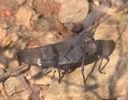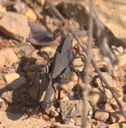Arphiini
Arphiini
Classification
- Phylum: Arthropoda
- Subphylum: Hexapoda
- Class: Insecta
- Order: Orthoptera
- Suborder: Caelifera
- Family: Acrididae
- Subfamily: Oedipodinae
- Tribe: Arphiini
Pronunciation
How to pronounce Arphiini: /ˌɑːrˈfaɪ.aɪˌnaɪ/
These audio files are automatically generated. While they are not always 100% accurate, they are a good starting point.
Images






Summary
The tribe Arphiini consists of small to medium sized grasshoppers characterized by their slender bodies, distinct coloration, and wide distribution from North to South America. Species within this tribe are often found in weedy fields and may exhibit high levels of crepitation. They are recognized for their bold colors during escape but can appear drab when feeling secure.
Physical Characteristics
Mostly small to medium sized species; slender bodies that are often deeper than wide; well-developed crest of the pronotum; thick antennae; coloring usually plain in grays or browns, sometimes with dark bands; hind wings usually yellow to pink or red with a dark cross band; hind tibiae can be brownish, yellowish, green, or blue, rarely black.
Identification Tips
The male epiphalus is bilobed, not trilobed; can crepitate with a buzz or crackling sound.
Habitat
Primarily inhabit xeric weedy fields.
Distribution
North America to northern South America.
Diet
Herbivorous, feeding on various plant materials.
Life Cycle
Information not detailed in provided content.
Reproduction
Information not detailed in provided content.
Predators
Common predators include birds and other insectivores that may confuse them with butterflies due to their colorful wings when threatened.
Conservation Status
Information not provided.
Ecosystem Role
They play a role in the food web as herbivores and as prey for various predators.
Economic Impact
Some species are considered important as locusts; notable species include Locusta migratoria (migratory locust) and Chortoicetes terminifera (Australian plague locust).
Cultural Significance
Not provided.
Health Concerns
No health concerns detailed in provided content.
Evolution
Related tribes include Chortophagini and Hippiscini, though molecular studies suggest they are not closely related despite morphological similarities.
Similar Taxa
Misconceptions
Some may confuse bandwing grasshoppers with butterflies due to their colorful hindwings when threatened.
Tags
- Arphiini
- Oedipodinae
- grasshoppers
- orthoptera
- insecta